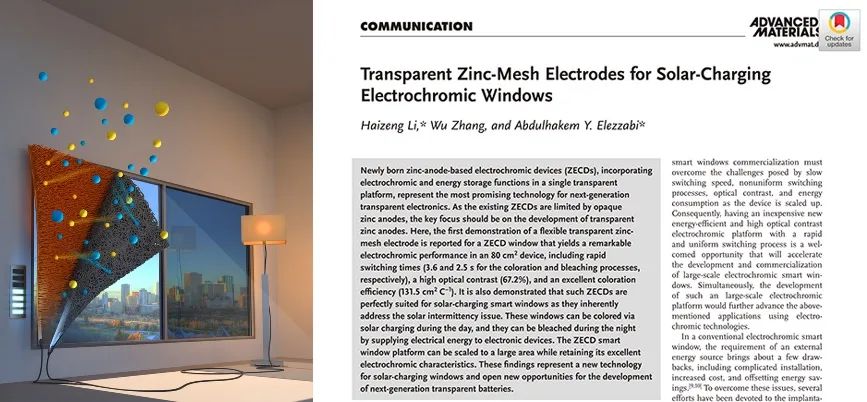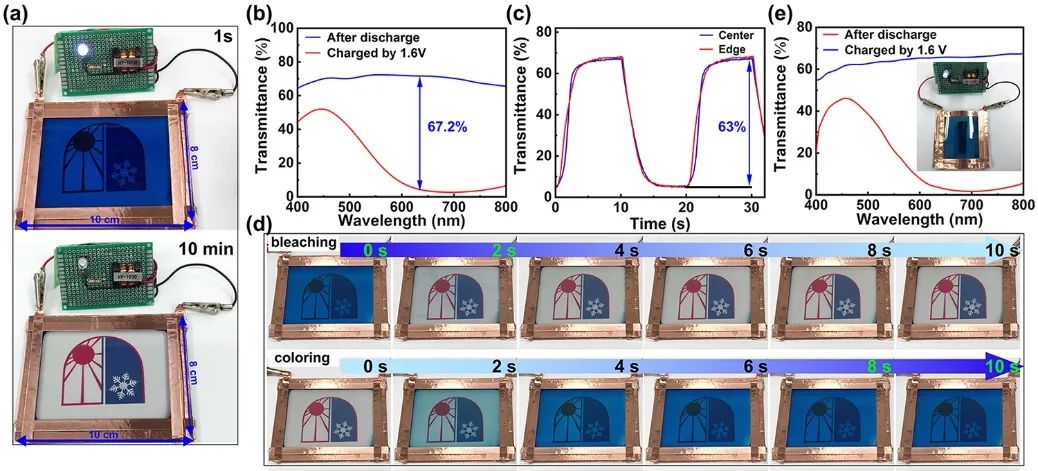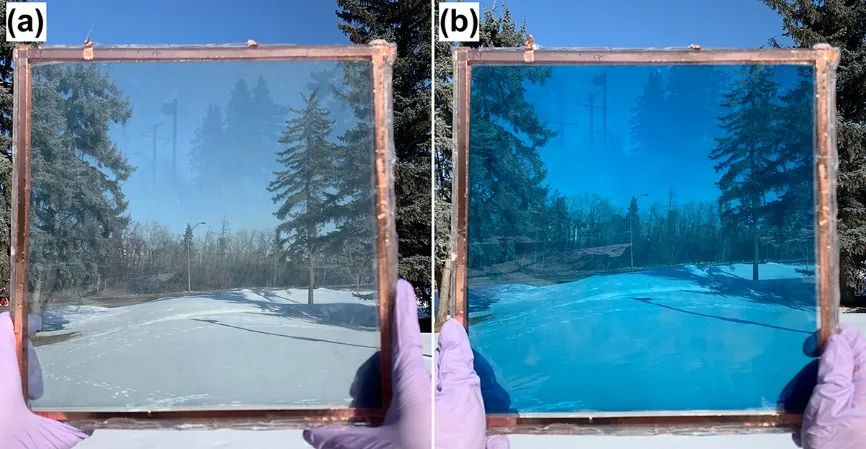建筑节能被认为是中国实现 2030 年碳减排目标的关键领域,且建筑节能技术是反映一个国家先进的重要标志。目前,建筑遮阳是为了避免阳光直射室内,防止建筑物的外围护结构被阳光过分加热,从而防止局部过热和眩光的产生,以及保护室内各种物品而采取的一种必要的措施。而传统的内遮阳技术采用室内窗帘,并无法阻挡热能,因此,内遮阳技术在现代建筑节能中仍面临着巨大的挑战。
近年来,可以在透明与不透明之间按需切换的电致变色智能窗应用而生。例如,波音787飞机以及国内一些手机制造商(e.g., VIVO, One plus等)都采用了传统电致变色技术,但是该电致变色技术需要使用外部电源才能变暗,并且褪色过程中仍需要外部电压,因此,该智能窗仍未对目前的建筑市场或者其他电子产品产生广泛的影响。为了降低电致变色智能窗的能耗,科学家们普遍采用太阳能电池为传统电致变色智能窗供能。但是,在夜晚或者阳光缺失时,无法工作的太阳能电池使得电致变色智能窗仍需外部电压使其褪色(如Figure 1a所示)。
Figure 1. Working principle comparison of the PV-electrochromic smart window systems. a) Schematic of a conventional PV-electrochromic smart window architecture and the color switching process. The configuration requires external energy to be supplied to bleach the electrochromic smart window in the absence of sunlight at night or during sunlight intermittency in the daytime. S1 and S2 represent a typical double-pole double-throw switch to manage the current. S3 represents a traditional switch for bleaching the electrochromic smart window via an external energy storage unit. b) Schematic of the PV-ZECD smart window architecture and the color switching process. This configuration can provide electricity to power electronics during bleaching and it does not require electrical energy to bleach the device. The PB film changes colors upon the conversion between Prussian white (colorless) and Prussian blue (blue). S1 and S2 represent typical switches.
基于上述时代背景与能耗需求,加拿大阿尔伯塔大学李海增等人近期提出了耗能可回收的新型电致变色技术,其不仅可以应用于耗能可回收的电致变色智能窗(Joule, 2019, 3, 2268; Adv. Mater., 2019, 31, 180706; Nanoscale Horiz. 2020, 5, 691),也可以广泛应用于透明多彩显示(Light Sci. Appl. 2020, 9, 121; Adv. Opt. Mater. 2020, 8, 1901224)。这种“锌”型电致变色器件不仅解决了对电极电荷不对称所带来的电解质分解问题,更大幅降低了电致变色器件的能耗问题。更为重要的是,这种“锌”型电致变色可以充分解决由于传统电致变色智能窗阳光缺失所面临的复杂电路装备问题(如Figure 1b所示)。
由于“锌”型电致变色器件是一种全新的电致变色器件,由李海增等人首次提出于2019年,而当前的“锌”型电致变色器件全部采用不透明的锌箔作为阳极,从而导致器件较慢的着色褪色时间,不均匀的着色/褪色过程。因此,开发用于“锌”型电致变色智能窗的透明“锌”电极刻不容缓。
Figure 2. Transparent Zn-anode-based electrochromic smart window architecture and characterization of the transparent Zn anode. a) Representative schematic of the transparent Zn-anode-based electrochromic window architecture. b) Illustration of the simulated spatial electric field distribution within the 80 cm2 ZECD window when a coloration voltage of 1.6 V is applied (a detailed explanation is provided in Figure S1, Supporting Information). c) SEM images of a single stainless-steel wire (i) and Zn-nanoparticle-coated stainless-steel wire (ii,iii). Scale bar: 10 μm. d) Optical transmittance spectra of a bare stainless-steel mesh and a core-shell-structured transparent zinc-nanoparticle anode. The inset in the left is a photograph of 10 cm × 13 cm transparent zinc anode, while the right inset shows a schematic core-shell structure of the zinc coating on a single stainless-steel wire.
经过精心设计,作者们开发了一种以透明不锈钢网为基底的锌纳米颗粒包覆的核壳结构,该结构可以有效避免传统锌箔持续不断地溶解产生锌离子,从而降低锌枝晶的产生以及提高普鲁士蓝的稳定性。通过电场模拟(Figure 2b),这种透明锌网可以使器件内部电场均匀分布,从而达到快速响应以及均匀变色的效果。而这种具有纳米锌涂层的不锈钢金属网格的透明度并没有明显降低,证明了这种透明锌网将是一种非常优异的可用于“锌”型电致变色智能窗的阳极材料。
Figure 3. Performance of the ZECD smart window. a) Photographs of a 0.5 V LED powered by the 80 cm2 ZECD smart window demonstrate a spontaneous bleaching process via conversion of chemical energy to electrical energy. b) Visible and near-infrared transmittance spectra of the 80 cm2 window measured at different states. c) Light transmission at 632.8 nm through the center (blue line) and the edge (red line) of the 80 cm2 window. d) Photographs of the ZECD smart window at different times during switching at 0.8 V for 10 s followed by 1.6 V for 10 s. The arrow indicates the direction of the evolution of the coloring and bleaching states. e) Visible and near-infrared transmittance spectra of a flexible 25 cm2 ZECD smart window. The inset shows the photograph of the flexible 25 cm2 ZECD smart window.
通过选择合适的电解质体系以及电致变色电极体系,作者们组装成了具有优异性能的80-cm2电致变色智能窗(Figure 3),该电致变色智能窗展示出非常优异的电致变色性能,包括67.2%的光调制范围,4 s 以内的响应时间,以及均匀的着色/褪色效果。尤其值得注意的是,由于这种透明锌网较好的柔韧性,其可以应用于组装柔性电致变色智能窗,为未来贴膜式智能窗的开发提供了无限可能。
如前文所讲,这种“锌”型电致变色智能窗能够完美解决太阳能电池在夜晚或者阳光缺失时无法工作所面临的问题。因此,作者们继续开展太阳能充电的“锌”型电致变色智能窗。如Figure 4所示,通过太阳能电池充电的“锌”型电致变色智能窗可以在白天将太阳能储存于智能窗内,并可以发生着色效果,从而起到遮阳生电的效果。而当夜晚来临,该智能窗又可将存储的太阳能以电能的形式释放出来,起到为室内家电供能的作用。而这种太阳能电池充电的“锌”型电致变色智能窗展示出了快速响应的特点,并且具有到目前为止最高的往返能源效率。
Figure 4. Solar-charging performance of the 80 cm2 ZECD smart window. a) Demonstration of the functionality of the homemade DC–DC converter, which regulates the output voltage from the silicon solar panel to a stable voltage of 1.646 V. b) Photographs of the 80 cm2 ZECD smart window in its colored and bleached states as it is charged by the PV solar panel and when discharged. c) Transmission at a light wavelength of 632.8 nm during the solar-charging process (solid blue line), and the galvanostatic discharge process at a current density of 0.25 mA m−2 (dotted blue line). The red line is the corresponding galvanostatic discharge curve, and the inset photograph shows an LED (0.5 V regulated) being lit up by the solar-charged ZECD smart window.
Figure 5. Photographs of a 30 cm × 30 cm ZECD smart window. a,b) The coloration effect of the window charged by the silicon PV solar panel. a) A bleached ZECD smart window before PV solar charging. b) A colored ZECD smart window after PV solar charging.
除此之外,该“锌”型电致变色智能窗还展示出了非常优异的尺寸可伸缩性,作者们在实验室条件下制备出了30 cm × 30 cm尺寸的智能窗,并且保持有较好的电致变色性能(Figure 5)。
该研究的最大意义在于作者首创的提出了透明锌网用于太阳能充电的“锌”型电致变色智能窗,其中多位审稿人认为该工作将会成为电致变色领域内的一个“launching point”。作者们也希望其开发的“锌”型电致变色器件能够受到各界同行们越来越多的关注。
作者其他工作扩展阅读:
1. 耗能可回收电致变色智能窗: Joule, 2019, 3, 2268; Adv. Mater., 2019, 31, 180706; Nanoscale Horiz. 2020, 5, 691。
2. 耗能可回收透明多彩电致变色显示:Light Sci. Appl. 2020, 9, 121; Adv. Opt. Mater. 2020, 8, 1901224。
3. 传统电致变色器件:Nano Energy, 2018, 47, 130; ACS Appl. Mater. Interfaces 2018, 10, 10520; ACS Appl. Mater. Interfaces 2019, 11, 20378; J. Mater. Chem. C, 2016, 4, 33; J. Mater. Chem. A, 2014, 2, 11305。
作者介绍:
李海增博士2016年毕业于东华大学纤维材料改性国家重点实验室,师从电致变色领域专家王宏志教授。自2011年以来,李海增博士一直从事电致变色光热调控器件的研究,着眼于光电集成技术的发展,从电致变色半导体材料到功能集成化系统器件形成了一个完整的有鲜明特色的研究体系,在理论设计、工艺实现和工程应用方面都取得了关键性的突破。近年来,李海增博士建立了一步溶剂热法制备高性能氧化钨半导体电致变色薄膜(J. Mater. Chem. A 2014,2,11305),开发了低成本高稳定性的可印刷电致变色半导体墨水(J. Mater. Chem. C 2016, 4, 33-38;Adv. Mater. Technol. 2017, 2, 1700047;Nano Energy 2018,47, 130-139),提出了纳米增材制造印刷电子技术复合薄膜的设计策略(ACS Appl. Mater. Interfaces 2018, 10, 10520),实现了低成本复杂结构的电致变色纳米半导体薄膜的构筑;并创建了新型耗能可回收电致变色集成系统(Adv. Mater. 2019, 31, 1807065(高被引论文)),解决了传统电致变色光热调控器件能耗以及电路设计存在的问题;提出了混合电解质体系用于高性能耗能可回收电致变色集成系统的设计思路(Joule 2019, 3, 2268(热点论文)),致力于下一代电致变色器件的绿色可持续发展的实用技术的研究;构建了基于耗能可回收电致变色集成系统的“透明多彩”显示新模式(Adv. Optical Mater. 2020, 8, 1901224; Light Sci. Appl. 2020, 9, 121),解决了传统电致变色显示器中电极对称性以及颜色多彩性等关键技术难题。此外,李海增博士与国内知名镀膜玻璃有限公司以及加拿大最大的窗户制造商All Weather Windows具有深度合作,掌握着低成本制备大面积智能窗的核心技术。
全文链接:






